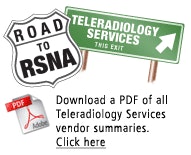Teleradiology offers much-needed additional capabilities for many hospitals and busy imaging centers. And for facilities unable to attract or afford subspecialists, teleradiology can provide access to highly trained and board-certified radiologists across the imaging spectrum.

Information technology is finally catching up to the demands of teleradiology. Thanks to Web-based software, high-speed Internet connections, and RIS functionality helping manage all demographic data, teleradiology services can provide unbelievably fast turnaround times to address critical care needs.
Finally, for rural healthcare settings lucky enough to have a general radiologist available, the door is thrown wide open to access subspecialty expertise never before dreamed of in such remote locations. So long as an institution has the imaging equipment, and a means to send the data elsewhere, it can have an experienced neuroradiologist evaluating its patients with possible stroke or head trauma.
Naturally, no good solution is without hurdles to its implementation. The need for licensed physicians, who hold licenses in the states in which the patient is receiving care, is one stumbling block. Currently, there is no national teleradiology license, nor is there a credential for international reading for that matter. An eye to the future suggests that circumstance is bound to change.
Many of today's teleradiology companies have obtained certification by the Joint Commission, which provides some level of comfort and confidence for their clients. Most services employ board-certified, fellowship-trained, experienced radiologists to do the heavy lifting.
Company's exhibiting at this year's RSNA conference will showcase new interpretation capabilities, improved technical support, and extra privacy and security safeguards for patients. And many companies are beginning to diversify their portfolios with locum tenens, educational opportunities, and consulting services added to their primary image interpretation activities.



















